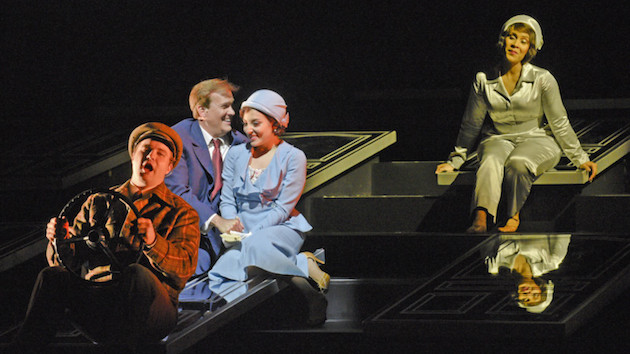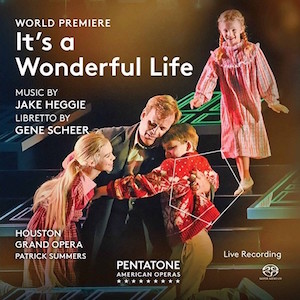
Life was anything but wonderful as people around the globe began the herculean task of recovering from the ravages of World War II, and yet it was in 1946 that Frank Capra directed his seminal film, It’s a Wonderful Life.
A holiday TV perennial for decades, Capra’s film speaks — in the director’s words — “of the importance of the individual ... that no man is a failure and that every man has something to do with his life.”
Optimism and the belief in the importance of the individual (and his vote) are not taken for granted today either, just before the all-important midterm elections, so it’s the right time for the opera version, the premiere of It’s a Wonderful Life in the War Memorial on Nov. 17.

San Francisco Opera’s education and communications departments organized an event this week for educators and journalists in the Wilsey Center in preparation for the opera by the writer-composer team of Gene Scheer and Jake Heggie. Dramaturg Kip Cranna, Heggie, and Scheer spoke of the opera. Soprano Kearstin Piper Brown performed excerpts from it.
Although known for his outgoing, warm, positive personality, Heggie has been composing some heavy, even tragic works, such as Moby Dick and Dead Man Walking, so he seems relieved and enthusiastic about It’s a Wonderful Life.
He boasts jocularly about writing “the only opera ever to conclude with a singalong,” cast and audience joining in “Auld Lang Syne,” text helpfully projected on a screen for the song to which nobody knows the words. Led by Heggie, Scheer, and Brown, the audience of a few dozen in the Wilsey made an effort to show what the finale may sound like next door in the 3,200-seat War Memorial.

(The prominent opera librettist David Scott Marley had a rejoinder to Heggie’s claim: “If you think that’s the only singalong in opera, we evidently haven’t been sitting near the same people.”)
Heggie spoke enthusiastically before about his involvement with the story: “Beyond the film, the story itself feels big emotionally... big enough to fill an opera house. To me, the emotions call out to be sung — they demand music. There’s much at stake in every scene because a man’s life literally hangs in the balance. And the story is, ultimately, about the redemptive power of love, community, and giving.”
Music stops, giving way to dialogue when George is visiting the places that would exist without him, and music returns when reality is restored. Both Heggie and Scheer confirmed this approach, noted not quite approvingly by the Opera News review of the Houston production: “There may be good and thoughtful musico-dramatic intentions behind the decisions to have the children of the cast only speak and never sing, and to abandon music altogether during the portion of the story in which George sees the world in which he was never born.”

For Scheer — also Heggie’s librettist for Moby Dick and Three Decembers — this was a labor of love, being the film’s greatest fan, knowing all the lines, and watching the film repeatedly. Heggie described with admiration Scheer’s “sacrifice” of going along with the composer’s request and cutting one of his favorite characters from the libretto, Mr. Gower, the drugstore owner.
 Originally produced and recorded by Houston Grand Opera in 2016, and later by Indiana University Opera Theater, the opera is still undergoing changes, especially in staging. Cranna referred to it as “Wonderful Life 3.0.” With the help of a large contribution, the set is much revised to Heggie’s satisfaction, eliminating a mirrors-filled scene, which limited lighting, leaving the stage dark.
Originally produced and recorded by Houston Grand Opera in 2016, and later by Indiana University Opera Theater, the opera is still undergoing changes, especially in staging. Cranna referred to it as “Wonderful Life 3.0.” With the help of a large contribution, the set is much revised to Heggie’s satisfaction, eliminating a mirrors-filled scene, which limited lighting, leaving the stage dark.
Once again, Heggie explained his reason for turning Clarence into Clara: “I didn’t want a tenor and a baritone sing[ing] all night.” Both he and Scheer emphasized that the opera is not meant to be “the movie onstage.”
Although this is believed to be the first opera version, the film had at least two musical stage adaptations: by Sheldon Harnick and Joe Raposo in 1991; by Bruce Greer and Keith Ferguson in 1998.
The San Francisco production is conducted by Patrick Summers, the stage director is Leonard Foglia, the set designer is Robert Brill.
In the cast: William Burden (George Bailey), Golda Schultz and Kearstin Piper Brown alternate as Clara, Andriana Chuchman (Mary Hatch), Rod Gilfry (Mr. Potter), Keith Jameson (Uncle Billy Bailey), Joshua Hopkins (Harry Bailey). In the Angel Quartet: Sarah Cambidge, Ashley Dixon, Amitai Pati, Christian Pursell.




